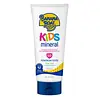What's inside
What's inside
 Key Ingredients
Key Ingredients

 Benefits
Benefits

 Concerns
Concerns

 Ingredients Side-by-side
Ingredients Side-by-side

Titanium Dioxide 4.5%
Cosmetic ColorantZinc Oxide 6.5%
Cosmetic ColorantWater
Skin ConditioningCaprylic/Capric Triglyceride
MaskingIsohexadecane
EmollientButyloctyl Salicylate
Skin ConditioningOctyldodecyl Citrate Crosspolymer
HumectantCetyl PEG/PPG-10/1 Dimethicone
EmulsifyingLauryl PEG-8 Dimethicone
C30-38 Olefin/Isopropyl Maleate/Ma Copolymer
EmulsifyingSodium Chloride
MaskingEthylhexyl Methoxycrylene
Skin ConditioningDimethicone
EmollientPhenoxyethanol
PreservativeCaprylyl Glycol
EmollientPEG-8
HumectantAlumina
AbrasiveGlycerin
HumectantSodium Citrate
BufferingTocopheryl Acetate
AntioxidantTitanium Dioxide 4.5%, Zinc Oxide 6.5%, Water, Caprylic/Capric Triglyceride, Isohexadecane, Butyloctyl Salicylate, Octyldodecyl Citrate Crosspolymer, Cetyl PEG/PPG-10/1 Dimethicone, Lauryl PEG-8 Dimethicone, C30-38 Olefin/Isopropyl Maleate/Ma Copolymer, Sodium Chloride, Ethylhexyl Methoxycrylene, Dimethicone, Phenoxyethanol, Caprylyl Glycol, PEG-8, Alumina, Glycerin, Sodium Citrate, Tocopheryl Acetate
Water
Skin ConditioningEthylhexyl Methoxycinnamate
UV AbsorberPhenylbenzimidazole Sulfonic Acid
UV AbsorberCyclopentasiloxane
EmollientOctocrylene
UV AbsorberDiethylamino Hydroxybenzoyl Hexyl Benzoate
UV FilterMethylene Bis-Benzotriazolyl Tetramethylbutylphenol
UV FilterPropylene Glycol
HumectantButylene Glycol Dicaprylate/Dicaprate
EmollientEthylhexyl Triazone
UV AbsorberSilica
AbrasiveArachidyl Alcohol
EmollientSodium Hydroxide
BufferingBehenyl Alcohol
EmollientPolysorbate 60
EmulsifyingXanthan Gum
EmulsifyingArachidyl Glucoside
EmulsifyingPhenoxyethanol
PreservativeAcrylates/Dimethicone Copolymer
Skin ConditioningBis-Ethylhexyloxyphenol Methoxyphenyl Triazine
Skin ConditioningDiethylhexyl Butamido Triazone
UV AbsorberSodium Citrate
BufferingDecyl Glucoside
CleansingCaprylyl Glycol
EmollientCellulose
AbsorbentHectorite
AbsorbentTremella Fuciformis Polysaccharide
Emulsion StabilisingEthylhexylglycerin
Skin ConditioningHexylene Glycol
EmulsifyingDisodium EDTA
BHT
AntioxidantBrassica Campestris Sterols
EmollientCetearyl Alcohol
EmollientSodium Hyaluronate
HumectantCarnosine
Skin ConditioningCitric Acid
BufferingEctoin
Skin ConditioningPanthenol
Skin ConditioningButylene Glycol
HumectantAllantoin
Skin ConditioningBetaine
HumectantHydrolyzed Collagen
EmollientTocopheryl Acetate
AntioxidantGlycerin
HumectantTrehalose
HumectantUrea
BufferingTheobroma Cacao Seed Extract
AntioxidantHydrolyzed Algin
Polyquaternium-51
Skin ConditioningPentylene Glycol
Skin ConditioningSerine
MaskingAlgin
MaskingDisodium Phosphate
BufferingGlyceryl Polyacrylate
Pullulan
Potassium Phosphate
BufferingWater, Ethylhexyl Methoxycinnamate, Phenylbenzimidazole Sulfonic Acid, Cyclopentasiloxane, Octocrylene, Diethylamino Hydroxybenzoyl Hexyl Benzoate, Methylene Bis-Benzotriazolyl Tetramethylbutylphenol, Propylene Glycol, Butylene Glycol Dicaprylate/Dicaprate, Ethylhexyl Triazone, Silica, Arachidyl Alcohol, Sodium Hydroxide, Behenyl Alcohol, Polysorbate 60, Xanthan Gum, Arachidyl Glucoside, Phenoxyethanol, Acrylates/Dimethicone Copolymer, Bis-Ethylhexyloxyphenol Methoxyphenyl Triazine, Diethylhexyl Butamido Triazone, Sodium Citrate, Decyl Glucoside, Caprylyl Glycol, Cellulose, Hectorite, Tremella Fuciformis Polysaccharide, Ethylhexylglycerin, Hexylene Glycol, Disodium EDTA, BHT, Brassica Campestris Sterols, Cetearyl Alcohol, Sodium Hyaluronate, Carnosine, Citric Acid, Ectoin, Panthenol, Butylene Glycol, Allantoin, Betaine, Hydrolyzed Collagen, Tocopheryl Acetate, Glycerin, Trehalose, Urea, Theobroma Cacao Seed Extract, Hydrolyzed Algin, Polyquaternium-51, Pentylene Glycol, Serine, Algin, Disodium Phosphate, Glyceryl Polyacrylate, Pullulan, Potassium Phosphate
 Reviews
Reviews

Ingredients Explained
These ingredients are found in both products.
Ingredients higher up in an ingredient list are typically present in a larger amount.
Caprylyl Glycol is a humectant and emollient, meaning it attracts and preserves moisture.
It is a common ingredient in many products, especially those designed to hydrate skin. The primary benefits are retaining moisture, skin softening, and promoting a healthy skin barrier.
Though Caprylyl Glycol is an alcohol derived from fatty acids, it is not the kind that can dry out skin.
This ingredient is also used as a preservative to extend the life of products. It has slight antimicrobial properties.
Learn more about Caprylyl GlycolGlycerin is already naturally found in your skin. It helps moisturize and protect your skin.
A study from 2016 found glycerin to be more effective as a humectant than AHAs and hyaluronic acid.
As a humectant, it helps the skin stay hydrated by pulling moisture to your skin. The low molecular weight of glycerin allows it to pull moisture into the deeper layers of your skin.
Hydrated skin improves your skin barrier; Your skin barrier helps protect against irritants and bacteria.
Glycerin has also been found to have antimicrobial and antiviral properties. Due to these properties, glycerin is often used in wound and burn treatments.
In cosmetics, glycerin is usually derived from plants such as soybean or palm. However, it can also be sourced from animals, such as tallow or animal fat.
This ingredient is organic, colorless, odorless, and non-toxic.
Glycerin is the name for this ingredient in American English. British English uses Glycerol/Glycerine.
Learn more about GlycerinPhenoxyethanol is a preservative that has germicide, antimicrobial, and aromatic properties. Studies show that phenoxyethanol can prevent microbial growth. By itself, it has a scent that is similar to that of a rose.
It's often used in formulations along with Caprylyl Glycol to preserve the shelf life of products.
Sodium Citrate is the sodium salts of citric acid. In skincare, it is used to alter pH levels and acts as a preservative.
Its main functions are to maintain the pH of a product and neutralize metal ions.
The acidity of our skin is maintained by our glands and skin biome; normal pH level of skin is slightly acidic (~4.75-5.5).
Being slightly acidic allows our skin to create an "acid mantle". This acid mantle is a thin barrier that protects our skin from bacteria and contaminants.
Learn more about Sodium CitrateTocopheryl Acetate is AKA Vitamin E. It is an antioxidant and protects your skin from free radicals. Free radicals damage the skin by breaking down collagen.
One study found using Tocopheryl Acetate with Vitamin C decreased the number of sunburned cells.
Tocopheryl Acetate is commonly found in both skincare and dietary supplements.
Learn more about Tocopheryl AcetateWater. It's the most common cosmetic ingredient of all. You'll usually see it at the top of ingredient lists, meaning that it makes up the largest part of the product.
So why is it so popular? Water most often acts as a solvent - this means that it helps dissolve other ingredients into the formulation.
You'll also recognize water as that liquid we all need to stay alive. If you see this, drink a glass of water. Stay hydrated!
Learn more about Water